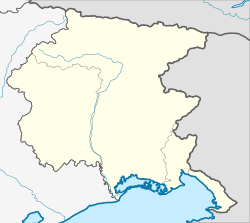
Back رسیا AZB Рэзія Byelorussian Резия Bulgarian Resia (Udine) Breton Resia Catalan Рези CE Resia (munisipyo) CEB Resia German Resia Esperanto Resia Spanish
Resia
Reśija (Slovene) | |
|---|---|
| Comune di Resia | |
| Coordinates: 46°23′N 13°18′E / 46.383°N 13.300°E | |
| Country | Italy |
| Region | Friuli-Venezia Giulia |
| Province | Udine (UD) |
| Frazioni | Prato, San Giorgio, Gniva, Oseacco and Stolvizza |
| Government | |
| • Mayor | Sergio Chinese (Civic Party) |
| Area | |
• Total | 119.0 km2 (45.9 sq mi) |
| Elevation | 492 m (1,614 ft) |
| Population (Jan. 2015)[2] | |
• Total | 1,048 |
| • Density | 8.8/km2 (23/sq mi) |
| Demonym | Resiani |
| Time zone | UTC+1 (CET) |
| • Summer (DST) | UTC+2 (CEST) |
| Postal code | 33010 |
| Dialing code | 0433 |
| Patron saint | Assumption of Mary |
| Saint day | August 15 |
| Website | Comune di Resia |
Resia (Resian: Reśija; Slovene: Rezija; Friulian: Resie) is a comune (municipality) in the Regional decentralization entity of Udine, in the Friuli-Venezia Giulia region of northeast Italy, bordering on the municipalities of Chiusaforte, Lusevera, Resiutta, and Venzone, and also on two of the Slovenian municipalities (Kobarid and Bovec). Its residents speak an archaic dialect known as Resian, which is – according to most linguists – a transitional dialect between the Carinthian and Littoral dialects of Slovene. Although they maintain their own traditional system of family names, which are of Slavic origin, the people of Resia have either Italian or Italianized surnames, similarly to some areas in Venetian Slovenia.
It is located in the alpine valley of the same name in the Julian Alps, about 90 kilometres (56 mi) northwest of Trieste and about 35 kilometres (22 mi) north of Udine, on the border with Slovenia and around 20 kilometres (12 mi) from the border with Austria. As of 1 January 2015, it had a population of 1,048 and an area of 119.0 square kilometres (45.9 sq mi).[3]
- ^ "Superficie di Comuni Province e Regioni italiane al 9 ottobre 2011". Italian National Institute of Statistics. Retrieved 16 March 2019.
- ^ "Popolazione Residente al 1° Gennaio 2018". Italian National Institute of Statistics. Retrieved 16 March 2019.
- ^ All demographics and other statistics: Italian statistical institute Istat.


